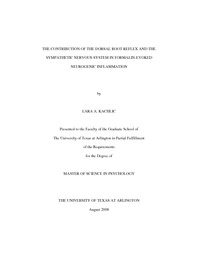| dc.description.abstract | The present study investigated the role of dorsal root reflex (DRR), which is characterized as antidromic firing via primary afferent fibers towards the periphery, and the sympathetic nervous system in neurogenic inflammation. Neurogenic inflammation is defined as inflammation that is caused by substances released from sensory nerve terminals (Willis Jr., 1999). The first objective of the study was to determine bilateral blood perfusion, a measure of redness, one of the cardinal signs of inflammation, following a formalin injection with the use of laser Doppler imaging. The hypothesis stated that there would be a bilateral increase in blood perfusion, following formalin. It was found that following an injection of an inflammatory agent, formalin, under pentobarbital general anesthesia, there was an ipsilateral increase in blood perfusion, but not in the contralateral paw. The lack of change of blood perfusion in the contralateral paw may have been due to the antagonistic effects of vasodilatation by the DRR and the vasoconstrictive effects of the sympathetic nervous system. The second objective of the study was to determine the role of DRR in blood perfusion in neurogenic inflammation. The hypothesis stated that by blocking DRR transmission to the ipsilateral side, there would be a decrease in blood perfusion to the ipsilateral side, and there would be no change in blood perfusion to the contralateral side, following formalin. The left sciatic nerve was transected following local lidocaine application, and formalin was injected into the left hind paw. The results showed a unilateral increase in blood perfusion in the ipsilateral side following formalin injection. This indicates that local axonal reflex may contribute to neurogenic inflammation. Additionally, the sympathetic nervous system may contribute to this inflammation indirectly through the release of norepinephrine in the periphery. The third objective of this study was to determine the role of the sympathetic nervous system in neurogenic inflammation. The hypothesis stated that by eliminating the sympathetic nervous system through chemical sympathetic block, there would be a greater bilateral increase in blood perfusion following formalin injection. Using the guanethidine chemical sympathetic block model, formalin injection in the sciatic transected animals caused an increase in blood perfusion in the ipsilateral paw, but not the contralateral paw. This indicates that local axonal reflex may play a larger role in neurogenic inflammation than previously expected. | en_US |

